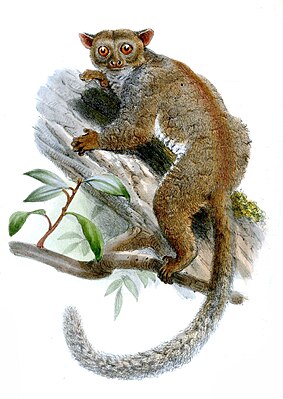Northern Kielnagelgalago
| Northern Kielnagelgalago | ||||||||||||
|---|---|---|---|---|---|---|---|---|---|---|---|---|

Northern keel nail galago ( Euoticus pallidus ) |
||||||||||||
| Systematics | ||||||||||||
|
||||||||||||
| Scientific name | ||||||||||||
| Euoticus pallidus | ||||||||||||
| ( Gray , 1863) |
The northern keel nail galago ( Euoticus pallidus ) is a primate species from the Galagos family (Galagonidae).
features
Northern keel nail galagos reach a head body length of around 20 centimeters, to which a tail around 30 centimeters long comes. The weight is around 300 grams. Their dense, soft fur is colored yellow-gray on the back, the belly is whitish. The nails are compact on the sides ("keel-shaped") and pointed at the front. This is an adaptation to their diet, which consists predominantly of tree sap, as well as the broad hands and feet as well as the forward protruding upper incisors , the elongated lower incisors and the canine-shaped anterior premolars . As with all Galagos, the eyes and ears are very large.
distribution and habitat
Northern Kielnagelgalagos are native to central Africa . Their distribution area includes southeastern Nigeria , western Cameroon and the island of Bioko, which is part of Equatorial Guinea . In Cameroon, the Sanaga River forms the border to the distribution area of the southern Kielnagelgalago . Their habitat are tropical rainforests.
Way of life
These primates are nocturnal tree dwellers that hardly ever get to the ground. During the day they sleep in self-made leaf nests, at night they go looking for food, moving around by running and jumping. Little is known about the social behavior of this species. The animals search for food alone, but may sleep in groups during the day.
nutrition
The diet of these primates consists primarily of tree sap. The broad hands and pointed nails are used to hold on to the vertical tree bark, the specialized teeth for gnawing the tree bark. Insects also make up part of their diet, but they rarely eat fruits.
Danger
The destruction of their habitat is the main threat to the Northern Kielnagelgalagos. However, no worrying decline in populations can be observed, which is why the species is listed by the IUCN as “ least concern” . The subspecies E. p. Endemic to the island of Bioko . pallidus , however, is considered a "high risk" ( endangered ).
The species is no longer kept in Europe, the only former owner is Berlin.
literature
- Thomas Geissmann : Comparative Primatology. Springer-Verlag, Berlin et al. 2002, ISBN 3-540-43645-6 .
- Ronald M. Nowak: Walker's Mammals of the World. 6th edition. Johns Hopkins University Press, Baltimore MD 1999, ISBN 0-8018-5789-9 .
supporting documents
Web links
- Information at theprimata.com
- Euoticus pallidus in the endangered Red List species the IUCN 2008 Posted by: S. Bearder, JF Oates & CPP Groves, 2008. Accessed on 9 second in 2009.